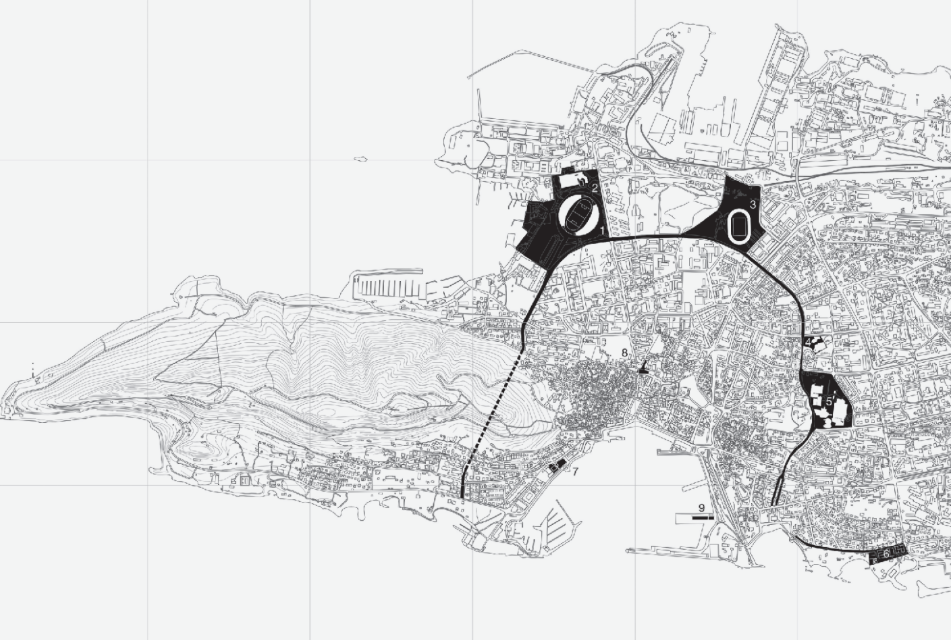Split’s Ring Road
Realizing Infrastructures for the VIII Mediterranean Games in 1979
DOI:
https://doi.org/10.31522/p.33.1(69).10Keywords:
ring road, Split, Croatia, urban infrastructure, urban planning, VIII Mediterranean GamesAbstract
The VIII Mediterranean Games held in Split (Croatia) in 1979 presented a transformative moment, catalyzing the implementation of long-envisioned urban plans through the completion of Split’s ring road. Within three years, this infrastructural backbone’s final development reshaped the city by connecting emerging subcenters of sports and other public programs with existing ones while linking Split’s southeastern and southwestern coastlines into a continuous system. The ring road facilitated the polycentric development conceptualized since the 1950s, integrating protective green zones with the subcenters, while addressing critical traffic challenges. This article examines the institutional framework that enabled this ambitious project, led by the Urban Planning Institute of Dalmatia - Split, and analyzes how the implementation bridged multiple scales from architectural to infrastructural vision. The ring road represents a uniquely contextual implementation of post-WWII urban plans, responding to Split’s particular topography and landscape while demonstrating how a mega-event provided momentum to realize comprehensive urban transformation with lasting impact on the city’s spatial organization.
References
Bajić-Žarko, N. and Marasović, K. (eds.) (2012) Dragutin Matošić: Pregled arhiva i dokumentacije Urbanističkog zavoda Dalmacije - Split (URBS) 1947-2008. Split: Državni arhiv u Splitu, Grad Split, Društvo arhitekata Splita, Fakultet građevinarstva, arhitekture i geodezije Sveučilišta u Splitu.
Bjelajac, S. (2009) Podijeljeni grad. Urbosociološka istraživanja o Splitu u razdoblju 1970.-1990., Split: Redak.
Grgić, A. (2011) Urbanističko planiranje i izgradnja otvorenih javnih prostora grada Splita. Arhitektonski fakultet Sveučilišta u Zagrebu.
Kalogjera, B. (1967) ‘Urbanističko projektiranje i realizacija’, URBS: 20 godina urbanističke organizacije, 7, pp. 21-28.
Kalogjera, B.; Matošić, M. and Pervan, B. (1966) ‘Organizacija urbanističke službe u Splitu’. URBS: Prostorni razvitak Splita, Urbanistički planovi i realizacije, 6, pp. 177-184.
Klempić, S. (2004) ‘Razvoj stambenih naselja Splita nakon Drugog svjetskog rata’, Hrvatski geografski glasnik, 66(2), pp. 95-120. https://doi.org/10.21861/HGG.2004.66.02.05
Markovina, D. (2018) ‘Mediteranske igre 1979.: Ključni korak modernizacije Splita’. In: Bodrožić, N.; Butković Mićin, L. and Šimpraga, S. (eds.) Pejzaži potrošačke kulture u socijalističkoj Jugoslaviji / Consumer Culture Landscapes in Socialist Yugoslavia. Zagreb and Eindhoven: Slobodne veze, Onomatopee 152, pp. 162-183.
Matošić, D. (1967) ‘Splitski urbanizam na pragu trećeg poslijeratnog decenija’. URBS: 20 godina urbanističke organizacije, 7, pp. 57-66.
Matošić, D. (2003) ‘Urbanistički zavod Dalmacije - Split 1947.-2004. i zbrinjavanje njegova arhiva’, Baština, 32, pp. 355-376.
Miličić, J. (2009) ‘MIS je Splitu dao klasu’. Slobodna Dalmacija, 5th September, p. 48.
Muljačić, S. (1969) ‘Izgradnja Splita 1944-1969’. URBS: Izgradnja Splita 1944-1969. Izdanje u povodu 25-godišnjice oslobođenja grada, 8-9, pp. 7-46.
Pervan, B. (1966) ‘Direktivni urbanistički plan iz 1951’. URBS: Prostorni razvitak Splita, Urbanistički planovi i realizacije, 6, pp. 35-44.
Petrić, T. (1986) Sport u Splitu 1944-1984. Split: Savez za fizičku kulturu općine Split, Samoupravna interesna zajednica fizičke kulture općine Split.
Petrov, A. (2019) ‘How Doing Sport Became a Culture: Producing the Concept of Physical Cultivation of the Yugoslavs’. In: Brentin, D. and Zec, D. (eds.) Sport in Socialist Yugoslavia. First edition. London and New York: Routledge, pp. 33-46. https://doi.org/10.4324/9780429452086-3
Pezo, V. (ed.) (1983) VIII Mediteranske igre Split 1979 / VIIIes jeux méditerranéens Split 1979 / VIII Mediterranean Games Split 1979. Split-Zagreb: Centar za industrijsko oblikovanje.
Salazar, N.B.; Timmerman, C.; Wets, J.; Gato, L.G. and Van den Broucke, S. (eds.) (2017) Mega-Event Mobilities: A Critical Analysis. London and New York: Routledge. https://doi.org/10.4324/9781315440125
Šimunović, I. (2019) ‘Budimir Pervan: tvorac suvremenog urbanizma Splita’. In: Bobovec, B. et al. Budimir Pervan - iz arhiva arhitekta. Zagreb: Hrvatski muzej arhitekture HAZU, pp. 31-35.
Tandarić, N.; Watkins, C. and Ives, C.D. (2019) ‘Urban planning in socialist Croatia’, Hrvatski geografski glasnik, 81(2), pp. 5-41. https://doi.org/10.21861/HGG.2019.81.02.01
Tušek, D. (1996) Arhitektonski natječaji u Splitu 1945-1995. Split: Građevinski fakultet Sveučilišta u Splitu, Društvo arhitekata Splita.
Viđak, V. (2002a) ‘Grad Split se više nego učetverostručio - Demografska kretanja na području Gradske Zajednice Općina Split od 1948.-1991. godine’. In: Ćurin, M. (ed.) Split u Titovo doba. Split: Društvo Josip Broz Tito, Savez antifašističkih boraca i antifašista, pp. 93-106.
Viđak, V. (2002b) ‘VIII. Mediteranske igre u Splitu - 15.-29. rujna 1979.’ In: Ćurin, M. (ed.) Split u Titovo doba. Split: Društvo Josip Broz Tito, Savez antifašističkih boraca i antifašista, pp. 301-307.
Zekić, J. (2016) ‘Mediteranske igre u Splitu - odrazi političke dimenzije u tiskanim medijima’, Časopis za suvremenu povijest, 48(1), pp. 97-117.
*** (1951) Direktivna regulaciona osnova grada Splita, Arhitektura, 5-8 (separat).
*** (1969) ‘Split, karta užeg dijela grada 1968.’ URBS: Izgradnja Splita 1944-1969, Izdanje u povodu 25-godišnjice oslobođenja grada, 8-9 (prilozi).

Downloads
Published
Issue
Section
License
Copyright (c) 2025 Andrea Čeko, Mia Roth-Čerina, Luka Skansi

This work is licensed under a Creative Commons Attribution 4.0 International License.
Copyright (c) 2021 authors and journal.
This work is licensed under a Creative Commons Attribution 4.0 International License.
Authors who publish with this journal agree to the following terms:
In agreeing this form, you certify that:
- You read the ethical codex of the PROSTOR available at journal web.
- You submitted work is your original work, and has not previously been published and does not include any form of plagiarism.
- You own copyright in the submitted work, and are therefore permitted to assign the licence to publish to PROSTOR.
- Your submitted work contains no violation of any existing copyright or other third party right or any material of an obscene, libellous or otherwise unlawful nature.
- You have obtained permission for and acknowledged the source of any illustrations, diagrams or other material included in the work of which you are not the copyright owner.
- You have taken due care to ensure the accuracy of the work, and that, to the best of your knowledge, there are no false statements made within it.
- All co-authors of this submitted work are aware of, and in agreement with, the terms of this licence and that the submitted manuscript has been approved by these authors.






